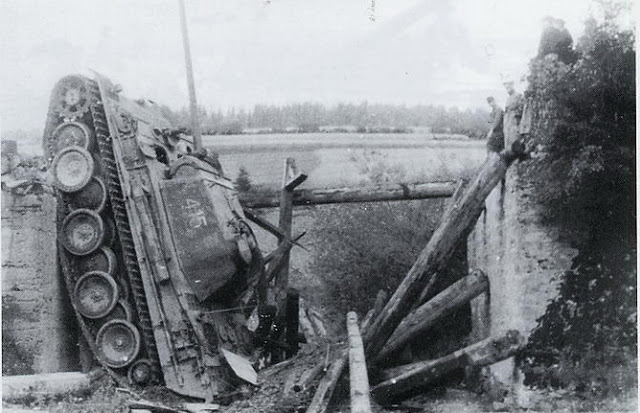As to the relative cost of tanks and bridges: the modern cost of a double/single Bailey Bridge (just a materials kit, and the most basic configuration) from Chinese suppliers, with actually superior quality (stronger steel, and fully hot dip galvanized instead of just lead-painted), is roughly US$50 a meter. Inflation since WWII has been very roughly 17X, so a WWII bridge might be estimated at US$3 a meter. Say the average WWII constructed bridge was about 50 meters, so that'd be more like $150 of materials. The US$50K for a test bridge is not likely representative of what was paid in volume, which is the right comparison.
Obviously that $150 doesn't include ancillaries and labor, whereas the tank cost for comparison does include those elements. But still, tanks were far more expensive on a unit basis than bridge kits. They contained lots of machining, a considerable proportion of armor steel, much more complicated fabrication, more-precise welding, lots of electricals and hydraulics, a powertrain, many moving parts, several guns, etc.
That's not to say that tanks and bridges don't have to both be paid for out of whatever budget you have. But, just as you can lose battles by not having good enough bridges or POL supplies or any other logistical and infrastructure element, you also can lose battles by having tanks that aren't as good as the other side's...perhaps because you went cheap on them.
I finally found a cost for Bailey bridges - $900,000 per mile to manufacture in the USA according to an article in The Military Engineer in 1945. They built 113 miles of them so the cost was about $10 million. It was about 35 bridges per mile, so each bridge mass-manufactured in the USA cost $26,000. That makes spending $50k to import a British bridge seem reasonable given its weight etc.
$26k may sound a lot for a bridge, but an article in The Army Engineer in 1945 states that each involved over 34,000 pieces with very fine tolerances required, and that each would provide a "double double" span of 150ft weighing about 100 tons. So these were big bits of kit, and the considerable trouble they had with the gauges (which were vital to ensure compatability) prove that they were not roughly built.
A Sherman tank cost about $45,000-55,000, so you get two locally-made bridges for one M4 tank - but that doesn't involve the 35 trucks needed to carry a Bailey. Assuming they were 2 1/2 tonners, there's an extra $100,000 there plus the extra 40 or so men to pay.
So let's assume a bigger Bailey-style bridge needs an extra six trucks, at $18,000, plus the bridge itself at $26,000. Now we're looking at each bridge costing as much as an M4, or 1.5 times as much as an M2 Medium.
The US Army's pre-war 10 ton pontoon bridge needed four semi trailers, four 6 ton trucks, two trailers and and two tractors carrying over 1000 parts. When upgraded to 25 tons the pontoons became impossible to manhandle and a crane was needed. The 25 ton pontoon bridge needed 16 semi trailers - a dramatic increase in costs.
The point is that to discount bridging costs, especially when you have not estimated those costs, is arguably ignoring vital factors in the US Army's pre-war thinking. In fact there seems to be no evidence for a claim that the USA Army failed to consider whether they should upgrade their bridges to get bigger tanks - they may well have considered it very deeply and found that it was cost-prohibitive. After all, they made a roughly similar calculation in WW2 when they decided that it was more important to ship M4s than Pershings, because they could ship (if I recall correctly) four M4s for every Pershing, and four M4s would be more efficient at ending the war.
And a US tank to fit on the old18 ton bridges didn't have to be anything like the 10 ton 7TP Polish tank or the Polish tankettes. The Somua S35 is widely said to be one of the best tanks of the early war at 19.5 tons; the A10 Cruiser was fairly good at 14 tons; the excellent Pz38(t) was less than 10 tons; the late Stuart M3 was 15 tons.
Seen in that light, and given the lower costs of lighter tanks (the M3 was about $30,000) can't it be said that the US Army may have been better off NOT spending the cost of upgrading their bridges at the time, and instead concentrating on building the world's best 18 ton tank, something which could have resulted in a very useful vehicle like a slower, more heavily armoured and upgunned M3? Wouldn't that have allowed them higher numbers that would have allowed better training and doctrine development, compared to getting significantly smaller numbers of bigger tanks because each tank would cost about 30% more and they'd also have to cut back tank numbers further to pay for the new bridging equipment?
We also know what happens to armies that say that they must have the best tank regardless of bridge load issues;
 More tanks v bridges....
More tanks v bridges....
By the way, a recent 170m Bailey bridge in New Zealand cost $6.5 million or the price of 6 Shermans (adjusted for inflation and currency). So the $150/metre charge is obviously way out of whack considering what they really cost. That NZ cost seems cheap compared to Bailey bridge modern costs in other countries. The Bailey bridge is widely reputed to be an outstanding piece of design, and older bridging kits probably cost a lot more per foot and per tonne of carrying capacity.

